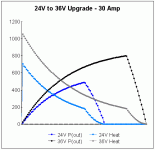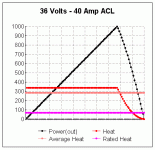Freddyflatfoot
1 kW
I came across a thread last night, and somewhere there was some discussion on the My1018 motor, and the power outputs that you can get from this little motor.
Ok, so (crudely speaking), power out is a linear relationship between volts, amps and efficiency. (volts x amps x % eff = power)
So if efficiency is relatively fixed, then I can change the other two variables, volts and amps, to increase the power output.
So my current setup, 24v, 15A, and ~80% eff = 288 watts.
I can increase my power by increasing the Amps by modding or using a different controller, say 20A, for 388 watts,
or I can increase the voltage to 36v, and say a 13 A controller for 375 watts.
So roughly the same power output, but in practical terms, how much differently does the motor behave?
I reckon Safe may have already tried this, and I do know that an increase in volts correlates to an increase in rpm, and an increase in amps correlates to an increase in torque. Although this is the standard way of thinking of this, I suspect that there may be an increase in both RPM's and torque for both changes, just one favouring torque, and the other favouring revs.
I also suspect that Safe will have a graph somewhere on this, showing the correlation.
But graphs don't show you how it relates to the bum in seat experience.
Can someone explain to me what would happen, in a practical sense, comparing the power increase in Amps, and then the same power increase in volts?
Thanks.
Ok, so (crudely speaking), power out is a linear relationship between volts, amps and efficiency. (volts x amps x % eff = power)
So if efficiency is relatively fixed, then I can change the other two variables, volts and amps, to increase the power output.
So my current setup, 24v, 15A, and ~80% eff = 288 watts.
I can increase my power by increasing the Amps by modding or using a different controller, say 20A, for 388 watts,
or I can increase the voltage to 36v, and say a 13 A controller for 375 watts.
So roughly the same power output, but in practical terms, how much differently does the motor behave?
I reckon Safe may have already tried this, and I do know that an increase in volts correlates to an increase in rpm, and an increase in amps correlates to an increase in torque. Although this is the standard way of thinking of this, I suspect that there may be an increase in both RPM's and torque for both changes, just one favouring torque, and the other favouring revs.
I also suspect that Safe will have a graph somewhere on this, showing the correlation.
But graphs don't show you how it relates to the bum in seat experience.
Can someone explain to me what would happen, in a practical sense, comparing the power increase in Amps, and then the same power increase in volts?
Thanks.



